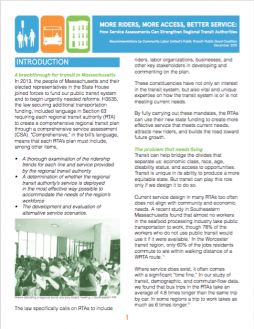More Riders, More Access, Better Service
Summary
More Riders, More Access, Better Service: How Service Assessments Can Strengthen Regional Transit Authorities
A breakthrough for transit in Massachusetts
In 2013, the people of Massachusetts and their elected representatives in the State House joined forces to fund our public transit system and to begin urgently needed reforms. H3535, the law securing additional transportation funding, included language in Section 63 requiring each regional transit authority (RTA) to create a comprehensive regional transit plan through a comprehensive service assessment (CSA). "Comprehensive," in the bill’s language, means that each RTA’s plan must include, among other items,
- A thorough examination of the ridership trends for each line and service provided by the regional transit authority
- A determination of whether the regional transit authority’s service is deployed in the most effective way possible to accommodate the needs of the region’s workforce
- The development and evaluation of alternative service scenarios.
The law specifically calls on RTAs to include riders, labor organizations, businesses, and other key stakeholders in developing and commenting on the plan. These constituencies have not only an interest in the transit system, but also vital and unique expertise on how the transit system is or is not
meeting current needs. By fully carrying out these mandates, the RTAs can use their new state funding to create more effective service that meets current needs, attracts new riders, and builds the road toward future growth.
The problem that needs fixing
Transit can help bridge the divides that separate us: economic class, race, age, disability status, and access to opportunities. Transit is unique in its ability to produce a more equitable state. But transit can play this role only if we design it to do so.
Current service design in many RTAs too often does not align with community and economic needs. A recent study in Southeastern Massachusetts found that almost no workers in the seafood processing industry take public transportation to work, though 78% of the workers who do not use public transit would use it if it were available. In the Worcester transit region, only 60% of the jobs residents commute to are within walking distance of a WRTA route.
Where service does exist, it often comes with a significant “time fine.” In our study of transit, demographic, and commuter-flow data, we found that bus trips in the RTAs take an average of 4.8 times longer than the same trip by car. In some regions a trip to work takes as much as 6 times longer.













